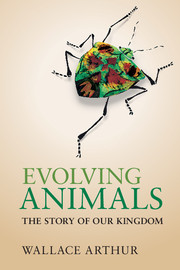Book contents
- Frontmatter
- Dedication
- Contents
- Preface
- Acknowledgements
- 1 What is an animal?
- 2 Before there were animals
- 3 How to make a fossil
- 4 The Cambrian explosion
- 5 How to make a species
- 6 Jellyfish and their kin
- 7 How to make a tree
- 8 The enigmatic urbilaterian
- 9 Animal symmetry and heads
- 10 A plethora of worms
- 11 Trends in animal complexity
- 12 Where the octopus is king
- 13 How to make an animal
- 14 Exoskeletons galore
- 15 Extinction
- 16 Mouth first, mouth second
- 17 Comparing embryos
- 18 Larvae, mouthparts and moulting
- 19 The animal toolkit
- 20 Vertebrate origins and evolution
- 21 From water to land to water
- 22 Variation and inheritance
- 23 Evolutionary novelties
- 24 Human origins and evolution
- 25 Animal plasticity
- 26 The nature of adaptation
- 27 The direction of evolution
- 28 Animal extremophiles
- 29 Extraterrestrial animals?
- 30 The ghost in the machine
- Appendix
- References
- Index
28 - Animal extremophiles
Published online by Cambridge University Press: 05 August 2014
- Frontmatter
- Dedication
- Contents
- Preface
- Acknowledgements
- 1 What is an animal?
- 2 Before there were animals
- 3 How to make a fossil
- 4 The Cambrian explosion
- 5 How to make a species
- 6 Jellyfish and their kin
- 7 How to make a tree
- 8 The enigmatic urbilaterian
- 9 Animal symmetry and heads
- 10 A plethora of worms
- 11 Trends in animal complexity
- 12 Where the octopus is king
- 13 How to make an animal
- 14 Exoskeletons galore
- 15 Extinction
- 16 Mouth first, mouth second
- 17 Comparing embryos
- 18 Larvae, mouthparts and moulting
- 19 The animal toolkit
- 20 Vertebrate origins and evolution
- 21 From water to land to water
- 22 Variation and inheritance
- 23 Evolutionary novelties
- 24 Human origins and evolution
- 25 Animal plasticity
- 26 The nature of adaptation
- 27 The direction of evolution
- 28 Animal extremophiles
- 29 Extraterrestrial animals?
- 30 The ghost in the machine
- Appendix
- References
- Index
Summary
Although the subject matter of this chapter is very different from that of the last one and the next one, a common theme running through all three is probability, or perhaps – though it’s really the same thing looked at from a different perspective – improbability. In the last chapter we saw that the nature of the developmental system made the evolution of certain kinds of animal improbable. In the next chapter we look at the probability of animal-type life on other planets. Here, we look at animals called extremophiles that live in parts of our own planet where animal life would at first sight seem improbable, and/or that have tolerance of extreme conditions.
Although these animals are indeed called extremophiles, this term is used also to describe other forms of life, from other kingdoms, that can withstand extreme environments. So the term can be used also for plants and fungi, and especially for organisms from the bacterial and archaean domains, where an extremophile existence is most commonly found. But here we’ll concentrate on extremophile animals. We’ll also concentrate on extremes of temperature; but it’s worth noting that extremophile can be used in relation to other environmental variables – for example acidity.
- Type
- Chapter
- Information
- Evolving AnimalsThe Story of our Kingdom, pp. 285 - 294Publisher: Cambridge University PressPrint publication year: 2014



